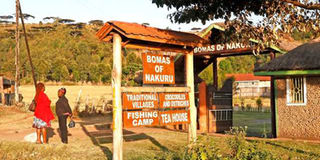Centre safely stores Kenya’s rich tribal heritage

The Bomas of Nakuru, some 30km from Nakuru on the Nakuru-Nyahururu road. PHOTO | FILE | NATION MEDIA GROUP
What you need to know:
The centre is a replica of the Nairobi-based Bomas of Kenya that preserves the traditional cultures of the Kenyan communities as well as promoting eco-tourism.
The Nakuru centre sits on a 50-acre plot and comprises a cultural heritage site, nature park, restaurant and a children’s arena.
Nakuru is a cosmopolitan county, whose population consists of people from different ethnic backgrounds.
The coming together of people from different ethnic communities has resulted in blending of cultural practices and socio-economic activities.
In a bid to promote peaceful and healthy coexistence, Bomas of Nakuru is playing a key role in helping people to learn and appreciate cultural values of different communities in the region.
The centre is a tourist resort that seeks to promote and preserve the cultural heritage of the communities in the county.
It is located in Berea, Subukia Sub-county, about 22 kilometres from Nakuru Town along the Nakuru-Nyahururu highway.
Promoting eco-tourism
The centre is a replica of the Nairobi-based Bomas of Kenya that preserves the traditional cultures of the Kenyan communities as well as promoting eco-tourism.
The Nakuru centre sits on a 50-acre plot and comprises a cultural heritage site, nature park, restaurant and a children’s arena.
A former area chief, Mr Stephen Waweru, is the director and founder of the site after he converted the farm he bought from a colonial settler to a heritage site.
His initial plan was to do farming, but after a series of discouraging yields, the man and his son decided to convert the field into a tourism resort in 2011. They embarked on renovation and redesigning of the structures to suit the purpose.
The centre was opened in 2015 by former Nakuru Governor Kinuthia Mbugua. Tourists, researchers and students started streaming in.
On entering the site, you’re welcomed by the sweet scent of roses meticulously grown on green lawns towards the main house.
The garden is normally used for wedding receptions and picnics.
Facing the garden is a house, whose design and materials tell of the many years it has existed.
Our guide Peter Mburu says the mansion was inherited from a white settler, who sold it to Africans as he left the country in the 1970s.
After renovation, the house was converted into an office and an indoor cafeteria where traditional meals are served by a team of well-trained chefs.
As you wait for service, you learn about Kenya’s social economic and political history from the various books and journals on the shelves.
Key points of interest include the traditional villages with at least 10 homestead for different Kenyan tribes, including the Gikuyu, Embu, Luhya, Luo, Kalenjin, Mijikenda, Kisii, Akamba, Teso and Kuria.
Visitors have a chance to see wildlife such as ostriches, monkeys, wild hare, guinea fowls, Egyptian geese and leopard tortoises.
There are also dams for crocodiles and fish ponds well secured with perimeter wire-mesh where visitors can have a closer look at the water animals.
Finally, there is an open field suitable for camping and games mostly used by corporate organisations for team building.
Apart from picnics and other recreational activities, the site acts as an important resource centre for researchers and schoolchildren who frequent the venue at affordable fees.
Is there a site you want us to feature? Write an e-mail to [email protected]





